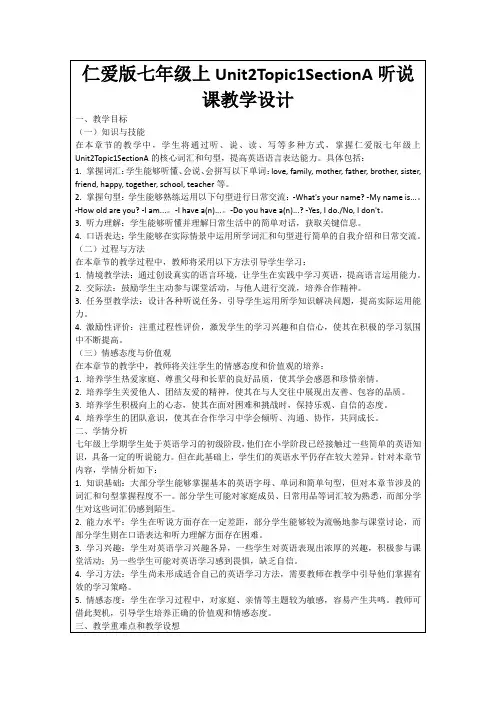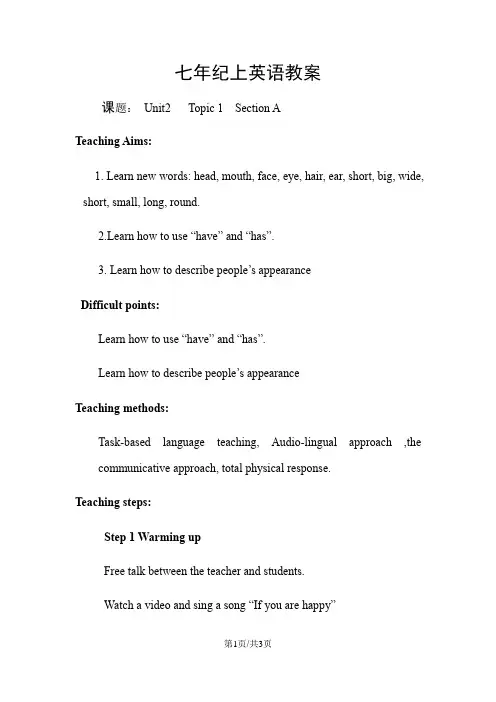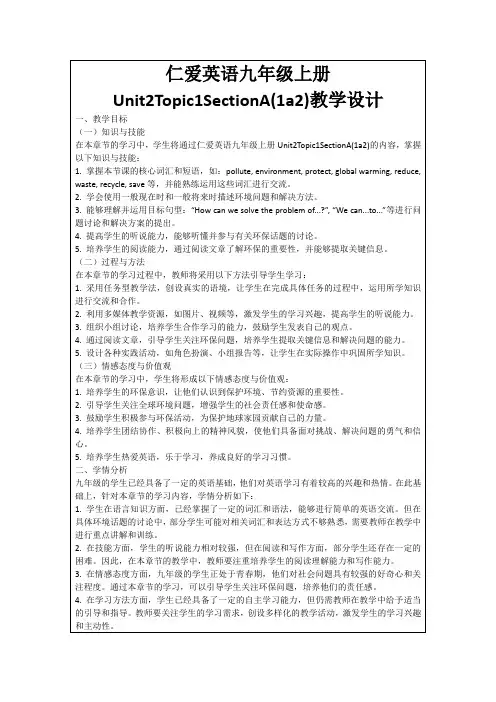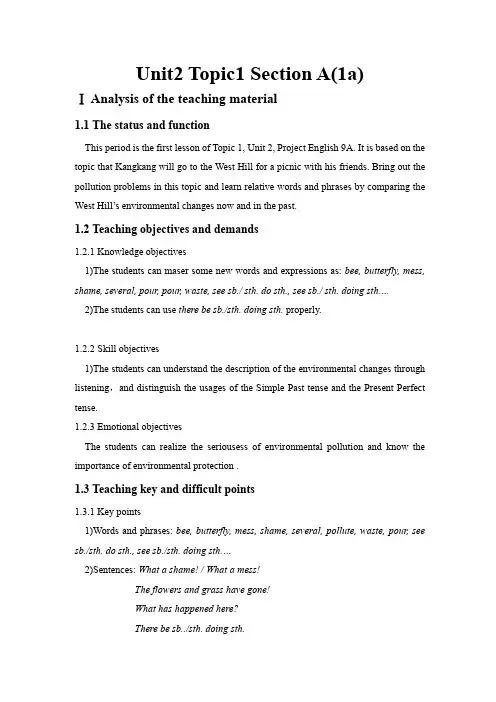Unit2Topic1SectionA优质课教案公开课
- 格式:doc
- 大小:20.00 KB
- 文档页数:6


八年级英语 Unit2 Topic 1 Section A的教学设计贵州沿河第四中学杨承斌The main activities are 1a, 1c and2.本课重点活动是1a、1c和2。
Ⅰ.T eaching aims and demands (教学目标及要求)1. Learn some useful words and expressions: (语言知识目标)toothache, dentist, cough, fever, flu, headache, at night, lots of, lift2. Help the students to learn the modal verbs for giving advice: (能力目标)(1)Y ou shouldn’t stay at home.(2)Y ou should see a dentist.3.Legality education aims(法制教育目标)Let students know they should go to the formal hospital after they fall ill. Build up their law awareness and the chat of medical treatment in our life。
. 让学生懂得生病后应该到正规医院看病,向学生渗透当今社会医疗中的行骗行为,增强学生的有关意料中的法律意识。
Ⅱ.Teaching key and difficult points(教学重难点)1.The spelling and pronunciation of the new words and phrases.2.The expressions of giving advice with should/shouldn’t .Ⅲ.Teaching methods (教学方法)1.According to the students’ statements, let the students know about the laws of medical treatment.2.Tell students to see the doctor when they doesn’t feel well.Ⅳ. T eaching aids (教具)cards , recorder, flash ,computerⅤ. Five-finger T eaching Plan 五指教学方案Step 1 Review 第一步复习(时间:5分钟)1. 复习Unit 1的内容。

七年纪上英语教案课题:Unit2 Topic 1 Section ATeaching Aims:1. Learn new words: head, mouth, face, eye, hair, ear, short, big, wide, short, small, long, round.2.Learn how to use “have” and “has”.3. Learn how to describe people’s appearanceDifficult points:Learn how to use “have” and “has”.Learn how to describe people’s appearanceTeaching methods:Task-based language teaching, Audio-lingual approach ,the communicative approach, total physical response.Teaching steps:Step 1 Warming upFree talk between the teacher and students.Watch a video and sing a song “If you are happy”Lead-inFrom this video ,we can see many words of body, like hands, feet and eyes. Do you want to learn more about them?Step 2 Presentation1.Learn the new words(1) Learn the new words: listen to 2a carefully and follow ithead, mouth, face, eye, hair, ear, nose, big,wide, short, big, wide, short, small, long, round.Let’s play the game Bobby Says. In order to go over the name of body.(2)Learn the new words: long short, big ,small, wide, round.show pictures and learn adjectives.2 .Remember the new words by themselves. Pay attention to their spellings. Have a competition.Step 3 Consolidation(Ask a student to stand up)T: Who is she?Ss: She is...T: Look, everyone, what does she look like? She has long hair and a round face. What about you? What do you look like?Step 4 listen to the tape 2a and learn how to use have\hasFinish2b and check answersEnjoy an English song “she has, he has”Step 5: Listen and follow 1aListen to the tape and finish 1b.Finish 1c according to 1a and 1b.1. Ask students to follow to read2. Show to read in groups3. Act it out.Step 6: Practice. Ask the students to describe the people in the screen write it down Do reportPlay a guessing game。


Unit2 Topic1 SectionA 优质课教案I.教学目标1. Learn some new words:(1) Learn words about parts of the body: nose, eye, head, face, hair, ear, mouth, neck.(2) Learn some other new words: guess, have, small, has, big, know, right, round, long, wide, girl, boy, short.2. Learn some useful sentences:(1) Oh, I know.(2) Yes, you’re right.3. Learn the simple present tense with “have/has” and adjectives of description:(1) I have a big nose.(2) They have round faces.(3) She has long hair.(4) It has big ears.4. Learn how to describe people’s appearances.Ⅱ.教具黑板、幻灯片课件Ⅲ.教学过程Step1借助体态语,帮助学生学习语言,并培养他们的观察能力。
1.(教师利用手势唱the Body Song,教师应按照从上到下、从局部到整体的手指人体部位,以便帮助学生记忆。
)Please listen and follow me, I will teach you a body song. Show me your hands and follow me. Please pay more attention to my fingers. I will touch the parts of my body. Let’s go!2.(利用2a的教学幻灯片,操练表示人体部位的名词。

Unit2 Topic1 SectionA 教学设计Ⅰ. Material analysis本课是第二单元第一话题的第一课时。
主活动是1a。
1a通过对比“West Hill”今昔的环境变化,引出本话题的污染问题,巩固现在完成时与一般过去时的用法及区别。
1b要求学生能够听懂一般过去时态和现在完成时态,也就是要分清1b 所提及的词语所伴随的时间。
1c则是在阅读之后再找出“西山”所发生的变化。
2通过观察图片内容,结对编对话,描述污染前后的情况,进一步训练学生口头表达能力和对一般过去时和现在完成时的运用能力。
3通过听并记录“动物的生存现状”,了解环境污染带给动物的危害,继续提高学生的听力水平。
任务4的口语表达,培养学生的说的技能,检测对本课的掌握情况。
通过本课的学习,培养学生关注环境问题的意识。
Ⅱ.Teaching aims1.Knowledge aims:掌握本课的重点词汇和短语,巩固一般过去时和现在完成时的用法和区别。
能够用一般过去时和现在完成时描述过去和现在的变化。
正确使用there be sth./sb. doing sth.来表达“有某人/物正在做某事”。
2.Skill aims:能听懂描述环境变化的对话,区别一般过去时和现在完成时的用法。
能理解和运用一般过去时和现在完成时来进行听、说、读、写活动。
3.Emotional aims: (optional)让学生了解环境污染的严重性,并树立环保意识。
4. Culture awareness: (optional)通过课文的学习,让学生了解环境的变化,关注全球的环境问题。
Ⅲ. The key points and difficult points1. Key points:Words and phrases: bee, butterfly, mess, shame, several, pollute, waste, villager, destroy, cut down, goodness, pour,see sb./sth. do sth., see sb./sth. doing sth., cut down, my goodness Sentences: What a shame! / What a mess!The flowers and grass have gone!What has happened here?There be sth./sb. doing sth.There are several factories pouring waste water into the stream.Everything has changed.Grammar: differences between Simple Past and Present Perfect tense.2.Difficult points:正确使用there be sth./sb. doing sth.来表达“有某人/物正在做某事” 。


Unit2 Topic1 Section A(1a)Ⅰ Analysis of the teaching material1.1 The status and functionThis period is the first lesson of Topic 1, Unit 2, Project English 9A. It is based on the topic that Kangkang will go to the West Hill for a picnic with his friends. Bring out the pollution problems in this topic and learn relative words and phrases by comparing the West Hill’s environmental changes now and in the past.1.2 Teaching objectives and demands1.2.1 Knowledge objectives1)The students can maser some new words and expressions as: bee, butterfly, mess, shame, several, pour, pour, waste, see sb./ sth. do sth., see sb./ sth. doing sth.…2)The students can use there be sb./sth. doing sth. properly.1.2.2 Skill objectives1)The students can understand the description of the environmental changes through listening,and distinguish the usages of the Simple Past tense and the Present Perfect tense.1.2.3 Emotional objectivesThe students can realize the seriousess of environmental pollution and know the importance of environmental protection .1.3 Teaching key and difficult points1.3.1 Key points1)Words and phrases: bee, butterfly, mess, shame, several, pollute, waste, pour, see sb./sth. do sth., see sb./sth. doing sth.…2)Sentences: What a shame! / What a mess!The flowers and grass have gone!What has happened here?There be sb../sth. doing sth.There are several factories pouring waste water into the stream.Everything has changed.3)Grammar: differences between the Simple Past tense and the Present Perfect tense.1.3.2 Difficult points1)To use there be sb./sth. doing sth. properly.2)To distinguish see sb./sth. do sth. and see sb./sth. doing sth.Ⅱ Analysis of the studentsStudents in Grade Nine have some cognitive abilities and their own opinions. They are not satisfied with just the content of the textbooks but hope to get more information and widen their eyesight through textbooks. Therefore,we should not teach the knowledge directly but in a way students can take part in learning by themselves and communicate and cooperate with others, in which they can experience, practice and explore by themselves. So teachers should pay more attention to combine the reality of the students and the topic of the textbook to arouse students’ interest to make them find, gain and use the information they need. Meanwhile, teachers should create a open, harmonious and interactive atmosphere in the teaching environment,where students can exchange their opinions, discuss, cooperate and act and make dialogs freely, thus inspiring students’ potentials,getting knowledge through autonomous and cooperative studying, forming their own way of studying English and improving their English study.Ⅲ Analysis of the teaching methodsThe Task-based learning method and the Situational teaching method can increase the class efficiency, arouse the students’ learning interest and make the students learn about teamwork.Ⅲ Learning strategies4.1 Previewing before class is a good way of learning.4.2 Reading the listening material and predicting before listening are good learning habits.4.3 It is helpful to retell the statements in the dialog.Ⅲ Teaching aidsThe multimedia teaching system, chalks, blackboard, some gifts and PPT.Ⅲ Teaching proceduresFive teaching stages:Stage 1 Lead-in (3-5 mins)Stage 2 Pre-listening 10-12mins)Stage 3 While-listening (10-12 mins)Stage 4 Post-listening (10-12 mins)Stage 5 Assigning homework (3-5 mins)Stage 1 Lead-inStep 1 GreetStep 2 learn the new words.Purpose: Students can concentrate on the interesting topic and master the new words .Stage 2 Pre-listeningStep 1 Step 2 learn the new words.Purpose: Students can reading the new words .Stage 3 While-listeningStep 1 Listen to 1a, check the answers in 1b.Step 2 Let students read la aloud and understand the content of 1a.Step 3 listen again and finish the table in 1c independently.. Purpose: Students can master the new words and expressions and consolidate the usage of the Simple Past tense and the Present Perfect tense. Students can know how to express now and the past differently and solve the difficult points. Students’ listening abilities will be improved . What’s more, students will be ready for speaking and retelling.Stage 4 Post-listeningStep 1 Watch a video of 1a, then practice the dialog in groups. Later ask one group to present in classStep 2 Understand the importent phrases.Step 3 Do some related exercises together in class..Purpose: Students can get more detailed information through readingg,consolidate and make good use of what they have learned and develop their abilities of reading and speaking. To help students realize the importance of environmental protection. To prepare for the senior high school entrance examination by combining the oral practice and written exercises.Stage 5 Assigning homeworkStep 1 Sum up the important words, phrases and sentences together.Step 2 Assign the homework.1. Read 1a.2. Finish Section A in your workbook.3. Preview Section B. Purpose: Students will get consolidations by summary. Finish exercises and consolidate the abilities of speaking and using English..Ⅲ Blackboard designⅢ Teaching reflectionThe activities in class cover all the key and difficult points of this lesson, and they are designed as a chain, so the former one will be helpful for the next. The students’ performance in those activities and exercises can tell the teacher how well they have learnt about this lesson, so the teacher can plan the following lessons better. With the help of the various teaching and learning methods, the students’ learning interest and initiatives are aroused. And their ability of using English to communicate is also improved.。

UNIT 2 Keeping HealthyTOPIC 1 You should brush your teeth twice a day.Section A教案【教学重点】1. 学生学会关于身体状况的表达以及怎样询问他人的身体状况:How are you feeling now? I feel /don’t feel well.。
2. 能听、说、读、写四会单词:model、runny nose、slight fever、high fever。
在学习的过程中培养学生综合运用语言的能力,能用更多的语句来丰富自己的语言,如:Glad / Sorry to hear that. Take care of yourself.【教学难点】1. How are you feeling now? I don’t feel well.本课的核心句子,询问和表达身体的状况。
runny nose、slight fever、high fever 三个表示病症的词组。
2. Glad / Sorry to hear that. Take care of yourself.用来丰富学生的语言,重在灵活应用。
【教具准备】病痛单词学习卡片,随堂PPT【教学过程】热身/复习〔Warm-up/Revision〕1.Sing an English song :Clap your hands2.问候,复习旧知T: Hello boys and girls. How are you today?Ss: …T: I’m very well. Because there will be an English party in our school tomorrow. I hope all my stude nts can enjoy my party. But I’m sorry to hear that some of my students are sick. Now let’s have a look. What’s the matter with them?2. 旧知复习,引入新知出示课件,学生进展问答练习,复习相关的疾病名称:headache、stomachache、toothache What’s the matter with Mike? He has a stomachache. What’s the matterwith John? He has a headache. What’s the matter with May? She has a toothache. T: They are sick. So I’m sorry to hear that. 〔在恰当的情境中引出新句子并讲授更容易让学生们承受。

Unit 2 Saving the Earth Topic 1 Pollution has caused too many problems.Section A 教学设计一、教学目标1. 掌握本课重点词汇和短语:bee, butterfly, mess, shame, several, pour, waste, villager, destroy, pollute, cut down2. 掌握本课重点句型:I went there two year ago.There were lots of flowers and grass.Oh, what a mess!The flowers and grass have gone.What has happened here?Look, there are several chemical factories pouring waste water into the stream.3. 通过读、听,获取Kangkang,Michaeal 和Jane关于西山污染所导致的变化的信息。
4. 巩固一般过去时和现在完成时。
5. 能够运用正确的表达对过去和现在的变化进行讨论和对话。
6. 了解环境污染的严重性,并树立环保意识。
二、教学重点及难点重点:1. 掌握本课重点词汇、短语和句型。
2. 通过读、听,获取Kangkang,Michaeal 和Jane关于西山污染所导致的变化的信息。
3. 巩固一般过去时和现在完成时。
难点:能够运用正确的表达对过去和现在的变化进行讨论和对话。
三、教学过程Task 1Step 1 Warming-up1.Guide Ss to talk about where they have traveled.【设计意图】通过谈论旅游过的景点,引入本课主题。
Step 2 Pre-listening1.Guide Ss to look at pictures and talk about the content.【设计意图】通过描述图片内容,在帮助学生提高获取图片信息的能力的同时,提高语言表达能力。

Unit 2 Topic 1 Section AThe main activitiesare 1a and 2a. 本课重点活动是1a和2a。
Ⅰ.Teaching aims and demands 教学目标1.Learn some useful words and expressions.(1)Learn words about parts of the body:nose, eye, head, face, hair, mouth, ear.(2)Learn other useful words and expressions:have, small, has, big, know, right, short, long, we, round, wide, girl, boy.2. Learn the simple present tense with“have/has”.(1)I have a small nose.(2)They have round faces.(3)She has long hair.(4)It has big ears.3. Learn how to describe the people’s appearances.This boy has a small face, small eyes, a big nose, a wide mouth and big ears.His hair is short.Ⅱ. Teaching aids教具小黑板/影片“Who am I”的封面或图片/录音机/教学挂图Ⅲ. Five-finger Teaching Plan 五指教学方案Step 1 Review 第一步复习(时间:15分钟)1. (挂出小黑板,利用小黑板上的图画与信息,进行师生互动问答,学生两两对话表演。
复习描述人的基本情况。
)(1)T: What’s her name?S1: Her name is Jane.T: How old is she?S2: She is twelve.T: Where is she from?S3: She is from Canada.T: What class is she in?S4: She is in Class Four, Grade Seven.T: What’s her telephone number?S5: It’s (010)9267-6929.(叫S6,S7就此对话表演。
课题Unit 2 Topic 1 Section A一、教学目标1.学习have / has 的用法。
2.学习部分关于人体部位的名称的单词和形容词 small ,big , right ,round , long ,wide.3.学习描述人体外貌。
二、教学过程:Step 1 预习提纲1.预习2a 和本课的形容词,然后将下列短语译为英语。
(1)一个大鼻子________________。
(2)两只大眼睛_________________。
(3)一张圆脸__________________。
(4)长头发____________________。
(5)长脖子_____________________。
2.预习3a 自己总结have / has 的用法。
Step 2 学习指导与巩固提高1.检查单词认读情况和预习题的正误,并纠错指导。
2.对错误进行再记忆。
同桌之间互检。
e the teacher`s facial parts, teach the new words nose ,eye , head , face ,hair ___________Eg. T : What`s this ?S: It`s_________4.利用下面的句型进行造句练习:(1) Teacher : I have a small nose . He \ She has big eyes .(2) ----- Do you have big eyes ? ----Yes , I do .4. Listen to 1a and follow it ; imitate the pronunciation and intonation . Teach and let students master the sentence patterns of 1a .(1) I have a small nose .(2) ---Do you have big eyes ? --- Yes , I do .(3) Oh , I know .(4) Yes , you`re right .5. Act out 1a in pairs . Finish 1b .Step 3 Practice 练习1.Listen to 2a and follow it .2.Work in pairs .Play the game “ Touch your body” . Finish 2b.3.Listen to 3a , then finish 3b .4.让学生用3a中的句型描述自己及他人的外貌特征。
Unit2Topic1SectionA优质课教案
Unit2的教学围绕有关健康方面的话题展开,内容层层递进,从身体不适谈起,到怎样保持健康,最后部分以如何预防疾病、合理膳食为主题。
SectionA为本单元的第一个部分,主要谈论身体各部分的病痛以及提出针对性建议,进一步训练学生的听、说、读、写综合运用英语能力,为本单元的其它教学内容作好铺垫,为后面的学习打下坚实的基础。
本节课的课型为听说课,第二单元谈论如何保持健康。
话题一介绍了感冒、头疼等常见病的名称,出现了疾病名称的词:toothache,backache,fever,cough,headache,stomachache等以及相对应的短语:haveacold,haveafever,haveacough,haveaheadache,haveatoot hache,haveabackache,haveastomachache等。
通过Kangkang和Betty的对话,呈现了询问生病情况的对话:
What'swrongwithyou?Ihavea…等,以及表达关心所提的建议:Youshould和Youshouldn't。
一、教学目标分析:
1.知识目标:
(1)掌握新单词:toothache,backache,fever,cough,headache,stomachache coffee,tea,dentist,plenty,plentyof,atnight,takearest,bo
iledwater.
(2)如何询问他人身体状况:
What'swrong/thematterwithyou?
Whatshouldhe/shedo?
(3)能正确运用以下短语进行书面表达:
haveacold,haveafever,haveacough,haveaheadache,haveatoot hache,haveabackache,haveastomachache等。
(4)能正确地运用should,shouldn't提建议:Youshoulddrinkenoughboiledwater.
Youshouldn'tdrinkcoffeeorteaintheevening.
2.能力目标:
(1)能听懂有关日常小病的名称及相关话题。
(2)能熟练地运用should,shouldn't针对日常小病提建议。
(3)能正确朗读介绍日常小病的对话或文章。
(4)能用should,shouldn't结合本单元短语描述日常生活小病并提出有益的建议。
二、教学重点、难点分析:
1.教学重点:
(1)本课的语法重点是:学生能运用“Youshould”和“Youshouldn't”提出建议。
(2)难点是:要求学生尽可能学会用英语描述疾病并能就疾病征求他人意见、给他人提建议等。
整合点:通过运用信息技术实现教学中充分发挥学生学习主体性作用,加大课堂的知识容量;能根据实际教学,形象、直观地展示教学内容,突出教学重点和难点,多媒体的介入给英语课堂教学注入了新的活力,优化了课堂教学结构,活跃了课堂气氛,激发了学生的学习兴趣,对提高教学效率起到了一定的作用。
本节课我运用信息技术为“任务情境”或“问题情境”的创设扫清障碍,为学生提供一个完整、真实的问题背景,减少知识与解决问题之间的差距;同时支撑物的表征、视觉本质又促进了学习共同体中成员间的互动、交流,即合作学习,驱动学习者进行自主学习。
合理地应用信息技术于英语教学,还有利于将设计的问题具体化,还原知识的背景,恢复其原来的生动性、丰富性,从而便于学生掌握知识、激发想象,化解课堂教学难点。
三、教学过程设计:
Step1Lead-in
1.T:Letusenjoyaradiotogether.
Ss:OK.
T:Doyoulikeit?
Ss:Yes.
T:Letusdoittogether.(师生一起做,教师并做点评)
T:Canyounamethepartofbody?
Ss:Yes.
T:Whatisthis?
Ss:Itisanose.(师生问答)
T:OK.Canyouguessthemeetingoftoothache?
S1:牙疼
1.T:Butthereissomethingwrongwithmybake,maybeIhaveabacka che,ifIcan’tmovemy neckquickly,maybeIhaveasoreneck.(教师动作展现)
Step2:Presentation
2.然后学习日常生活中常见的各种疾病。
(通过多媒体呈现)
3.OK,letisplayagame:复习以上各种疾病短语(通过小组比赛形式)
(设计意图;通过用实景教学激活学生已有知识来引入新单词、新句型,为本节课的活动设置情景以及做好句型准备。
)
Step3:
1.让学生听1a录音,完成相关问题。
2.Showsomepictures,askandanswerinpairs.(以学生的照片展示,吸引注意力)
3.T:Listento1aandanswerthequestion.(Thereissomethingwro ngwithKangkang.Whatisit?Pleaseopenyourbookandlistento1a ,thenanswerthefollowingquestions)
(1)What'swrongwithKangkang?(2)Whatshouldhedo?
4.Listento1aagain.(注意语音和语调)
四、keypoints:
What'swrongwithsb?Ihave…/She/He/has…
Step1让学生根据不同疾病给予不同的建议。
(多媒体展示)(根据所学should和shouldn't的用法,并练习巩固)
Step2Practice
Letusplayagame.(Whoisabestdoctor?)(设计意图:活跃课堂气氛,激发学生学习英语的兴趣,培养学生实际运用英语能力。
)Step3Let’ssummarize
Step4:Showapicture(名言警句与图片结合,帮助学生树立健康理念,情感得到升华)
Step5:Dothehomework
2.做一个像这样的对话:Makeadialogwithyourclassmateslikethis:
A:Hi!What'swrongwithyou?
B:Ihavea…
A:I'msorrytohearthat.Youshould…
B:IthinkIwill.
A:Ihope…
B:Thankyou.
五、教学反思:
1、在设计教学的过程中,努力贯彻以学生为主体的教学新理念,注意调动学生学习的积极性和主动参与的感情,整合教材,设计的活动符合学生的年龄特点。
鼓励和引导学生积极发言,力求各个活动环环相扣,以符合学生的思维特点和认知水平。
2、通过创设各种问题情境,吸引学生的注意力,营造宽松愉悦的学习气氛,特别之处在于探究活动的过程中,设置一些问题启发学生思考、讨论,有效地突破教学难点。
本节课还有一些需要改进之处:
1、时间分配需要更合理。
由于引入和练习环节稍超出预设范围,为使教学时间不超时,在后面讨论环节,未能让更多学生畅谈,深感遗憾。
2、在教学过程中,语速有些快,影响学生的理解,所以我在今后的教学中,应注意这些细节的处理。